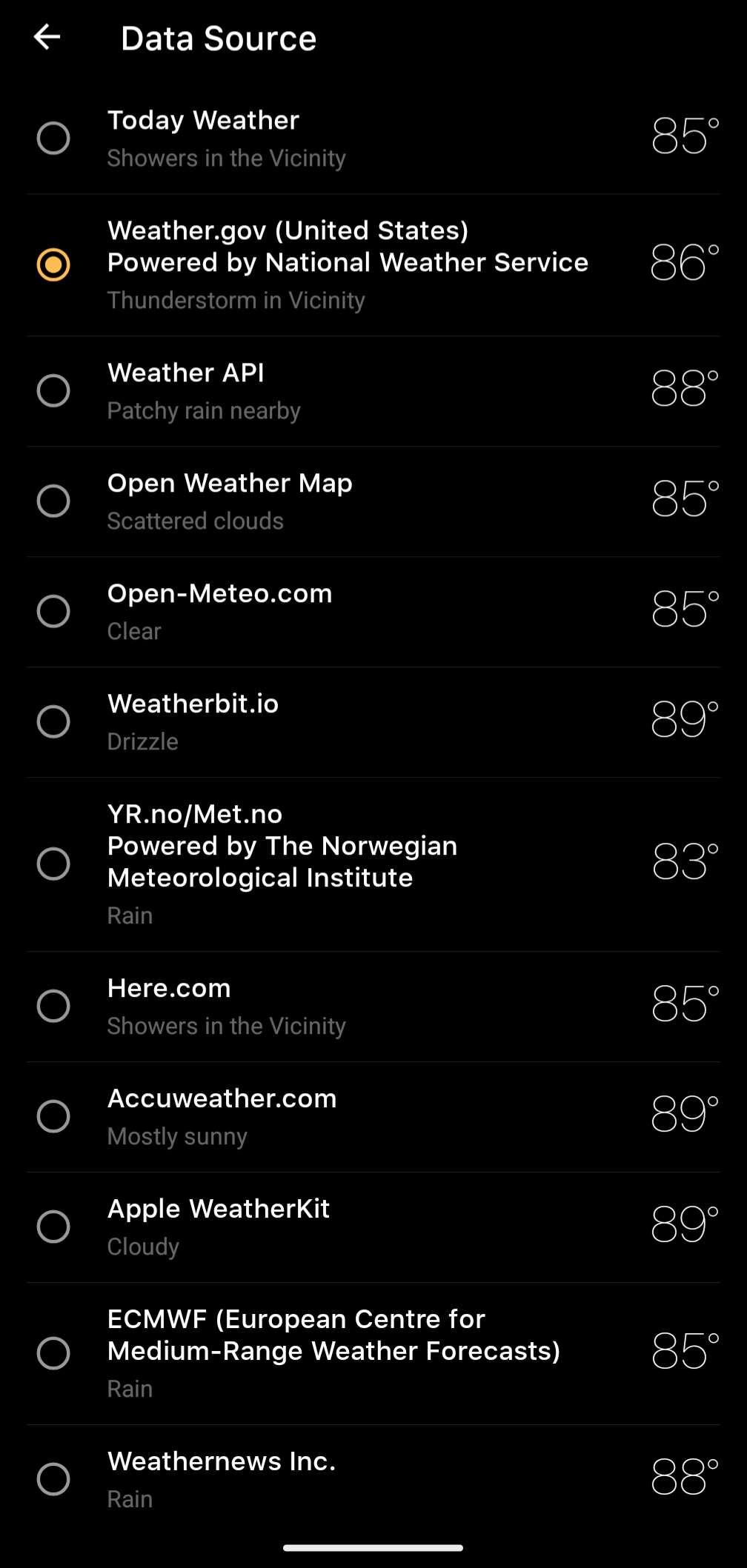I understand that weather on TV can’t be hyperlocally accurate. But a weather app on my phone has my exact GPS coordinates. Why can’t it tell me exactly when a rain cloud will be passing over my location?
It’s gotten to the point where I just use precipitation maps to figure out my rain chances for the day.
The hourly forecast is mostly useless because it’s not a chance % but a % of the area that will be raining.
Because we have tons of ground-level sensors, but not a lot in the upper layers of the atmosphere, I think?
Why is this important? Weather processes are usually modelled as a set of differential equations, and you want to know the border conditions in order to solve them and obtain the state of the entire atmosphere. The atmosphere has two boundaries: the lower, which is the planet’s surface, and the upper, which is where the atmosphere ends. And since we don’t seem to have a lot of data from the upper layers, it reduces the quality of all predictions.
Weather prediction at point locations is extremely challenging to get right because we simply can’t observe and make predictions for every single square inch of the earth. Many weather models are run on grids with boxes about the size of a few kilometers at the smallest scale, which means that any physical process in the atmosphere that is the size of that box or smaller won’t be represented well by the model.
Specifically on your point about clouds passing over your location, cloud and precipitation formation is even more challenging. Clouds and precipitation form due to atmospheric processes ranging from hundreds of kilometers all the way down to micrometers, which practically means the weather models are making an educated guess (albeit a very good one that is informed by scientific research) about when and where clouds will form. And when a model does predict a cloud, it will cover an entire grid box.
Finally, I saw you made a comment about how machine learning should improve forecasts, and in fact it does! But the weather community is still working on data driven models (as opposed to models that solve physical atmospheric equations), and most of them are run by private companies so their output is not free. As these data driven models get better, it may be possible that they will be able to make predictions at scales less than a kilometer.
This is a really thoughtful and educational answer. I learned a lot from this. Thank you!
I notice the rain predictions are quite a bit more accurate in the cooler months. You can see a weather front traveling west to east as it comes across the country (I’m in US) and rains can last all day. During the hotter parts in summer rain clouds appear out of nowhere usually in the afternoon and rains are heavy but brief. This happened here in NE Ohio just an hour ago. There was no forecast for rain that I was aware of but suddenly we got doused for twenty minutes.
For one thing, there’s two competing weather services providing the data to countless apps in the US and one of them has more money to throw around than the other.
The weather channel has better weather predictions overall than Apple’s own weather app, as rated by Forecastadvisor.com, but is not as accurate as Accuweather is although it’s used in more apps.
Weather is about tracking and predictions. It’s never going to be completely 100% correct. But taking a hodgepodge of information from several prediction services means you’re more likely to be less accurate overall despite what people may think.
Which are the two? NOAA and what else?
NOAA is one, the US armed Forces is the other. Not including info provided from other weather agencies outside the US.
All of those weather services just pull data from NOAA. There’s no competition, besides making up stuff beyond what NOAA predicts.
If all the private company weather services were only getting their info from the NOAA we wouldn’t have such varying results most of the time. Which is basically my point. The results vary because they don’t just use the NOAA’s data and predictions. The second one is actually the US Armed Forces.
Weather Underground allows you to filter down to your zip code. Not accurate down to your exact vicinity, but better than the weather forecast for your entire city.
But a weather app on my phone has my exact GPS coordinates. Why can’t it tell me exactly when a rain cloud will be passing over my location?
Because they’ve never been able to do that…
When they say “50% chance of rain”, it doesn’t meant there’s a 50/50 chance it rains where you’re located
It’s that for the broadcast area, about half is gonna get rain.
Unless I misunderstood what you said, that’s not it either. 50% chance of rain means exactly that: according to their forecast models, there is a 50% change it will rain. Snopes did a writeup of this.
Key word “in the given forecast area”.
The statement “there’s a 40% chance of rain at any given point at any given time in the forecast area/period” is an average over both area and time.
Many different actual distributions of rain could result in that average, including a 100% chance of it raining 100% of the time in 40% of the are or a 40% chance of it raining in 100% of the time in 100% of the area, and a 100% chance of it raining 40% of the time in 100% of the area. Real distributions are typically messier than that.
Can’t trust snopes any more
yeah, never mind the references in the article where they pointed out the evidence for their conclusions. :P
Says who? And what evidence?
Reading Snopes will give you plenty. Read the articles - and a lot of them use weasel-wording to push the result they want.
I don’t have the exact article on hand at the moment, but an example would be someone claiming that clear-cutting 1000 acres of trees would destroy [X]^3 of CO2 reduction; and then Snopes will “fact check” it by saying they aren’t cutting down 1000 acres of trees this year. Often times they’ll ‘debunk’ something that sounds like the claim, but isn’t the actual claim.
That’s not a correct understanding of how Snopes works. They debunked this.
We’ve investigated ourselves, and have found nothing wrong!
I think you just restated their joke.
It’s that for the broadcast area, about half is gonna get rain.
Isn’t that virtually the same thing as a 50% chance of rain at my position though?
Yeah, kind of. It’s going to rain. That’s the forecast. That rain will effect half of the area in their forecast range.
That’s not how that works
No, because clouds—and weather patterns in general—are not necessarily uniform across an area.
No it doesn’t, it means that under those conditions, about 50% of the times it has rained in that area
MyRadar is scary good, in my experience.
The hourly forecast is mostly useless because it’s not a chance % but a % of the area that will be raining.
Unless your precise location is a statistical outlier these will be the same thing?
Not really. Using % of forecast area as % chance of rain inherently gives equal weight to your position being anywhere within that area. Even if you limit the forecast area to the 5m or whatever it is radius that smartphone GPS is typically accurate to which a weather app could theoretically do, simply using % of the forecast area covered as % chance of rain inherently gives equal probability of you being literally anywhere within that 5m radius. It would obviously still be more accurate, but those numbers wouldn’t be the same thing.
I just looked at my weather app (Today Weather), and the report of the current temperature varies by 6°F depending on which data set I choose. I go with the National Weather Service (federal govt).

As far as predicting precipitation, the radar seems pretty good for the next few hours. I press play on it, and it tells me what it thinks the radar will look like for the next 7 hours in 15 mins increments.
I think that predicting the weather beyond a day gets pretty difficult because the weather is too chaotic. The best they can do is to gather data from local weather stations and see how often it rained when they had these same data in the past. So basically, it’s like saying, “When the temp has been 85°F, humidity 62%, wind from WNW at 5 kts, pressure at 1016 mBar, and the date was July 29, it rained 6 times out of 10.”
I use MyRadar for everything. Have for years. https://apps.apple.com/app/id322439990
You must be 14. Science doesn’t work like that.
Maybe they are 14. They’re just trying to understand. You, however, are an asshole.
MinuteCast from AccuWeather does exactly this. It looks at your location, looks at radar data for storm systems approaching your location, and estimates when precipitation will start at your location and how intense it will be. It’s generally pretty accurate, with some limitations. It seems to be pretty good for consistent rainstorms but it can get tripped up by pop-up thunderstorms, where the radar track can go suddenly from no rain to downpour. It doesn’t make predictions more then 2-3 hours out because past that timeframe it’s not easy to predict if weather will continue on its current track or change direction. Even with the limitations, I use it all the time. Mostly to tell if I should take the dogs out right away, or if I should wait an hour or two.
Weather.com also has real-time alert . You get notifications for rain about 30-40 minutes in advance based on specific location
This is exactly what I’m looking for! I also often check the weather to get a gauge on whether it’s clear to walk my dogs. 2-3 hours ahead is perfect.
NOAA sources are usually good in the US, weather.gov for a quick map and search by zip code or city, but they follow the same % system mentioned as most do
The couple apps/widgets I’ve tried haven’t been good for working with VPN unless I want to know the weather halfway around the world.
I went to Amsterdam over the weekend. The weather apps said it was gonna rain, did it fuck. I brought my puffer jacket and was almost dying from the heat until I got to the hotel room. Never had to wear it during the trip.
Look at a weather map with animated radar overlay. You will often see precipitation approaching and can predict how soon based on its speed and heading.









